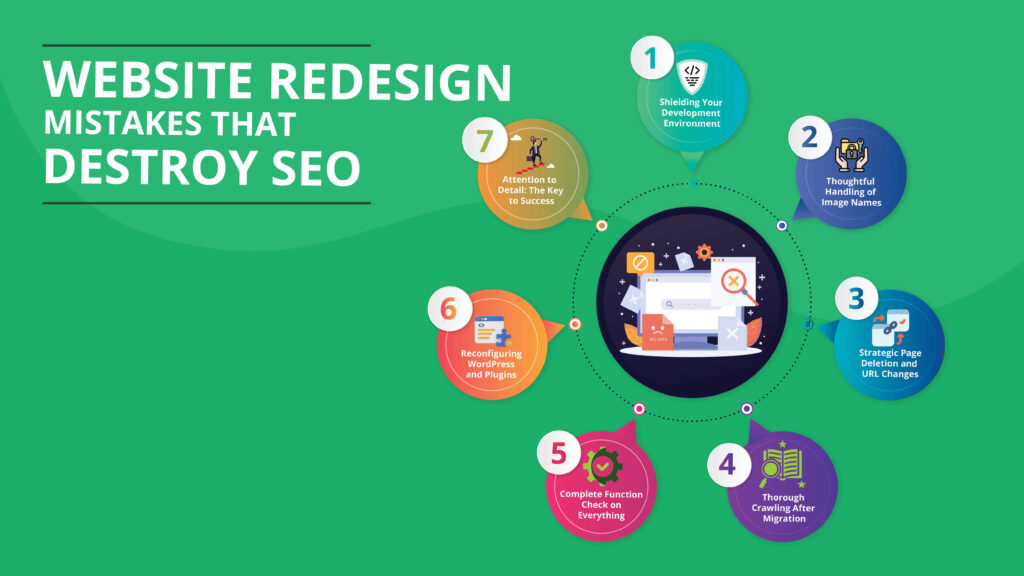Introduction
In the ever growing digital era, redesigning a website is one of the crucial tasks to stay relevant and to meet your user expectations at the same time. However, this process has its own set of challenges, particularly when it comes to maintaining and improving your websites SEO.
In this comprehensive guide, we will be looking into the potential drawback of website redesign and will be providing you with some valuable insights to ensure that your SEO efforts remain intact. As per the studies and research done by me I’ll share my expertise on steering clear of these common mistakes.
Also Read: Bluehost Website Builder Vs Elementor
Website Redesign Mistakes that Destroy SEO:

1. Shielding Your Development Environment:
One of the major mistakes website developers do during website redesign is leaving the development environment crawlable or indexable by search engines. As a precaution, I do recommend a meticulous approach to protect your development space.
First step to Create a clean URL with no prior associations, disallow bots through robots.txt, set up an empty index page, and consider password protection by implementing an SSL certificate in your website. By successfully implementing these measures, you can prevent search engines from indexing multiple versions of your website.
Also Read: Subdomain Tracking in Google Analytics
2. Thoughtful Handling of Image Names:
Changing image names in pages on a regular basis that already rank well can create a detrimental impact on SEO. This is a common oversight, especially when inexperienced web designers are involved.
As Sujit Shukla advises, when redesigning a website, be extremely cautious with altering image names, as it can strip away valuable context that search engines use for ranking. Choose descriptive and SEO-friendly names to maintain the relevance and ranking of your web pages.
Also Read: Why hire a Social Media Agency
3. Strategic Page Deletion and URL Changes:
Deleting your website pages or changing page URLs without proper redirection can lead to severe consequences for your SEO. When restructuring your site, it’s crucial to redirect your deleted or relocated pages using a 301 redirect. This ensures that search engines understand the changes and will redirect the traffic from the old page to the new one.
Sujit Shukla emphasizes that this not only helps you to preserve the rankings of the website but also prevents negative user experiences, as visitors won’t encounter dead-end 404 pages.
Also Read: Google Business Page for Realtors
4. Thorough Crawling After Migration:
Migrating a website between development and live environments without getting your website a downtime can introduce errors in links and content. It is always recommended by Sujit Shukla to use tools like Screaming Frog or SEMrush to properly identify and rectify your misplaced links.
This is one of the necessary steps you have to take in order to prevent issues caused by links pointing to the wrong locations, ensuring a seamless transition between development and live servers.
Also Read: How to Save Google Analytics Data to your Database
5. Complete Function Check on Everything:
After migration, conducting a comprehensive function check is essential. Beyond visual inspection, thoroughly test the necessary and valuable elements such as contact forms, e-commerce features, search capabilities, interactive tools, multimedia players, analytics, and verification tools like Google Search Console and Bing Webmaster Tools.
This meticulous testing guarantees that every aspect of your website not only looks right but functions correctly.
Also Read: Why SEO Audit is Important
6. Reconfiguring WordPress and Plugins:
Neglecting to reconfigure WordPress settings and plugins after migration can cause consequences. As leaving search engine restrictions enabled post-migration can lead to a significant drop in Google’s Search engine.
Immediately after migration, double-check the WordPress settings and plugins related to SEO, redirection, sitemaps, schema, and caching. Do thoroughly Uncheck any boxes restricting search engine crawlers to ensure optimal visibility.
Also Read: How to Remove Twitter from Linkedin
7. Attention to Detail: The Key to Success:
In the world of website redesign, detailing is the paramount. Sujit Shukla emphasizes that while these mistakes may seem straightforward to avoid, their impact can be profound.
It is best to Stay vigilant and implement a comprehensive plan, and pay meticulous attention to every detail to ensure a successful website redesign without compromising your SEO efforts.
Conclusion
Website redesign is necessary to stay competitive in this digital landscape. However, overlooking the potential SEO pitfalls can be detrimental. By following Sujit Shukla’s comprehensive guide, you can effectively navigate and redesign the process with confidence, ensuring that your website not only meets the evolving needs of users but also helps you to maintain visibility and authority in search engine rankings.
For more in-depth insights into digital advertising and marketing strategies, explore our blog at sujitshukla.com and stay ahead in the competitive world of online business.






